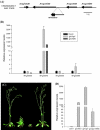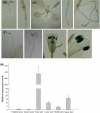Over-expression of the IGI1 leading to altered shoot-branching development related to MAX pathway in Arabidopsis
- PMID: 20473553
- PMCID: PMC2898107
- DOI: 10.1007/s11103-010-9645-0
Over-expression of the IGI1 leading to altered shoot-branching development related to MAX pathway in Arabidopsis
Abstract
Shoot branching and growth are controlled by phytohormones such as auxin and other components in Arabidopsis. We identified a mutant (igi1) showing decreased height and bunchy branching patterns. The phenotypes reverted to the wild type in response to RNA interference with the IGI1 gene. Histochemical analysis by GUS assay revealed tissue-specific gene expression in the anther and showed that the expression levels of the IGI1 gene in apical parts, including flowers, were higher than in other parts of the plants. The auxin biosynthesis component gene, CYP79B2, was up-regulated in igi1 mutants and the IGI1 gene was down-regulated by IAA treatment. These results indicated that there is an interplay regulation between IGI1 and phytohormone auxin. Moreover, the expression of the auxin-related shoot branching regulation genes, MAX3 and MAX4, was down-regulated in igi1 mutants. Taken together, these results indicate that the overexpression of the IGI1 influenced MAX pathway in the shoot branching regulation.
Figures







Similar articles
-
The Arabidopsis MAX pathway controls shoot branching by regulating auxin transport.Curr Biol. 2006 Mar 21;16(6):553-63. doi: 10.1016/j.cub.2006.01.058. Curr Biol. 2006. PMID: 16546078
-
The HAT2 gene, a member of the HD-Zip gene family, isolated as an auxin inducible gene by DNA microarray screening, affects auxin response in Arabidopsis.Plant J. 2002 Dec;32(6):1011-22. doi: 10.1046/j.1365-313x.2002.01488.x. Plant J. 2002. PMID: 12492842
-
Hormonally controlled expression of the Arabidopsis MAX4 shoot branching regulatory gene.Plant J. 2005 Nov;44(4):569-80. doi: 10.1111/j.1365-313X.2005.02548.x. Plant J. 2005. PMID: 16262707
-
Interactions between auxin and strigolactone in shoot branching control.Plant Physiol. 2009 Sep;151(1):400-12. doi: 10.1104/pp.109.137646. Epub 2009 Jul 29. Plant Physiol. 2009. PMID: 19641034 Free PMC article.
-
Mechanisms of floral repression in Arabidopsis.Curr Opin Plant Biol. 2003 Feb;6(1):29-35. doi: 10.1016/s1369-5266(02)00014-6. Curr Opin Plant Biol. 2003. PMID: 12495748 Review.
Cited by
-
Genome-wide analysis of proline-rich extension-like receptor protein kinase (PERK) in Brassica rapa and its association with the pollen development.BMC Genomics. 2020 Jun 15;21(1):401. doi: 10.1186/s12864-020-06802-9. BMC Genomics. 2020. PMID: 32539701 Free PMC article.
-
Genome-Wide Analysis and Characterization of the Proline-Rich Extensin-like Receptor Kinases (PERKs) Gene Family Reveals Their Role in Different Developmental Stages and Stress Conditions in Wheat (Triticum aestivum L.).Plants (Basel). 2022 Feb 11;11(4):496. doi: 10.3390/plants11040496. Plants (Basel). 2022. PMID: 35214830 Free PMC article.
-
Analysis of Arabidopsis glucose insensitive growth mutants reveals the involvement of the plastidial copper transporter PAA1 in glucose-induced intracellular signaling.Plant Physiol. 2012 Jul;159(3):1001-12. doi: 10.1104/pp.111.191726. Epub 2012 May 11. Plant Physiol. 2012. PMID: 22582133 Free PMC article.
-
Genome-wide co-expression analysis predicts protein kinases as important regulators of phosphate deficiency-induced root hair remodeling in Arabidopsis.BMC Genomics. 2013 Apr 1;14:210. doi: 10.1186/1471-2164-14-210. BMC Genomics. 2013. PMID: 23547783 Free PMC article.
-
Insight into the Roles of Proline-Rich Extensin-like Receptor Protein Kinases of Bread Wheat (Triticum aestivum L.).Life (Basel). 2022 Jun 23;12(7):941. doi: 10.3390/life12070941. Life (Basel). 2022. PMID: 35888032 Free PMC article.
References
-
- Bangerth F. Response of cytokinin concentration in the xylem exudate of bean (Phaseolus vulgaris L.) plants to decapitation and auxin treatment, and relationship to apical dominance. Planta. 1994;194:439–442. doi: 10.1007/BF00197546. - DOI
Publication types
MeSH terms
Substances
LinkOut - more resources
Full Text Sources
Molecular Biology Databases

